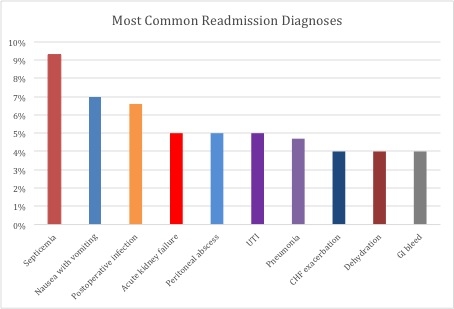30 DAY READMISSION AFTER SLEEVE GASTRECTOMY: INCIDENCE, MORTALITY AND INPATIENT COSTS
Violeta Popov*2, Marc Georgi3, Christopher C. Thompson1
1Brigham & Women's Hospital, Boston, MA; 2Gastroenterology & Hepatology, NYU Langone Health, New York, NY; 3Gastroeneterology, Palmetto Health USC, Columbia, SC
Introduction: Sleeve gastrectomy (SG) has emerged as an effective method to treat obesity and has become the most commonly performed bariatric surgery in the U.S. A small proportion of all SGs (6.1%) were performed as an inpatient procedure based on published estimates in 2014. The patients undergoing inpatient SG are likely at a higher surgical risk, however, adverse events, healthcare costs and readmissions associated with these procedures have not been investigated in a nationwide sample.
Aims: To determine the 30-day mortality, causes, and costs of readmission following inpatient SG using the largest national readmission database. Secondary aims included evaluating independent risk factors for readmissions.
Methods: This is a retrospective cohort analysis of the 2014 Nationwide Inpatient Readmission (NRD) database. Cases were included if they had an ICD 9 procedure codes during their index admission indicating SG. A readmission was defined as the first admission to any hospital for any non-trauma diagnosis within 30 days of the index admission. Same day admissions and discharges were excluded. The primary outcomes were 30-day readmission and mortality rates. Secondary outcomes were the most common readmission diagnosis and resource utilization (length of stay and hospitalization total costs). Independent risk factors for readmission were identified using multivariate regression analysis.
Results: A total of 6094 patients who underwent inpatient SG in 2014 were captured in the 2014 NRD database. 8.3% (483 patients) were readmitted within 30 days. Post-operative inpatient mortality was 4.7% (287 patients) for the index admission, and 3.4 % for the 30-day readmission. Mean age was 57.1, 59 % were female, mean LOS was 10.4 days, and with a mean charge per patient of 134,668 USD. The cumulative length of stay of all readmitted patients was 2,953 days, with a total cost of 6.45 million dollars, and total charges of 24 million dollars. The most common 30-day readmissions were related to infections, dehydration and vomiting, and exacerbation of chronic disease (Figure 1). Older age and ICU stay during the index admission were significant predictors of readmission (Table 1).
Conclusion: Sleeve Gastrectomy performed in the inpatient setting is associated with a high mortality rate of 4.7% for the index procedure, and a high 30-day readmission rate of 8.3%, with a 30-day readmission mortality of 3.4%. These numbers exceed those for most bariatric procedures, including gastric bypass. Further studies evaluating modifiable risk factors, patient-level and hospital-level characteristics associated with mortality, and other available treatment options for this high-risk population are warranted.
Table 1. Univariate and multivariate risk factors for 30-day readmission. OR, odds ratio; 95%CI, 95% confidence interval
| Factor | Univariate Odds Ratio Mortality | Multivariate Odds Ratio | ||||
| OR | 95% CI | P | OR | 95% CI | P | |
| Age | 1.01 | 1.003, 1.02 | 0.009* | 1.01 | 1.001, 1.02 | <0.001* |
| Female | 1.16 | 0.8, 1.5 | 0.3 | 1.24 | 0.9, 1.7 | 0.18 |
| Income by ZIP code (highest quartile vs. the other) | 0.77 | 0.5, 1.2 | 0.2 | |||
| ICU stay on index admission | 1.9 | 1.2, 3.1 | 0.006* | 1.8 | 1.1, 2.9 | 0.02* |
| Shock on index admission | 1.4 | 0.7, 2.9 | 0.4 | |||
| Hospital bedside (largest vs others) | 1.4 | 0.8, 2.4 | 0.09 | |||
| Teaching vs non-teaching | 0.86 | 0.6, 1.1 | 0.3 | |||

Figure 1. The ten most common principal diagnoses for 30-day readmission following inpatient SG
Back to 2019 Posters




